It is becoming increasingly true that when people mention soccer in America, they are talking about MLS (Major League Soccer).
However, the USA has a rich history of playing soccer (or football as the Brits call it), and here at Soccer Society we are interested in all of it, not just MLS.
For example, did you know that there are 5 different professional soccer leagues in America? Below that, there are a large number of amateur and college leagues too, so there is far more soccer played across the country than many of us hear about.
That’s what SoccerSoc is all about. Shining a light on all aspects of American soccer. Of course, the MLS is a huge part of that so you will find a lot of Major League content on the site, but far more besides.
A good place to start though, is with the history of the sport in the USA, and you can find out all about that below.
A Complete History of Soccer in the United States of America
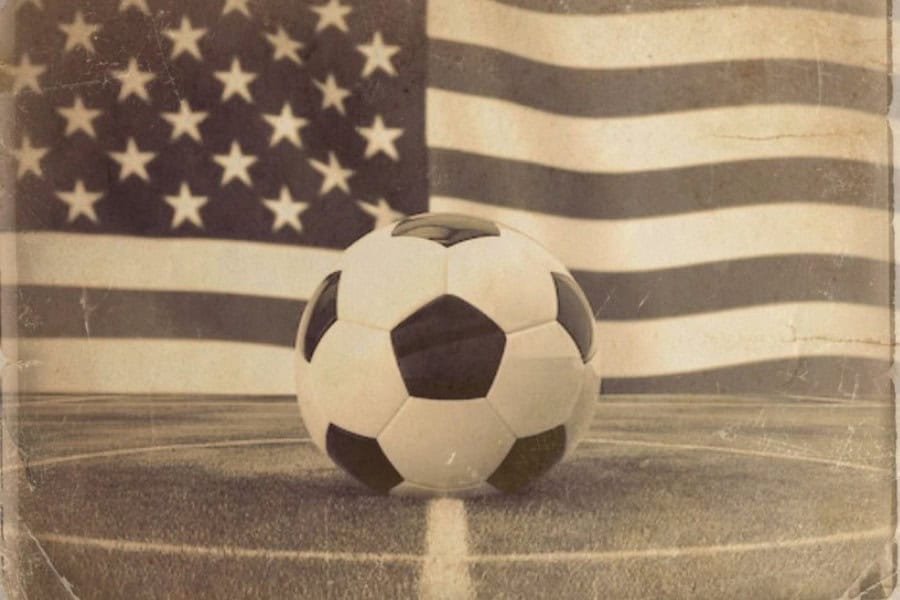
From its humble beginnings in the 19th century to its current status as a major professional sport, soccer has carved out a unique place in American sports culture, evolving from an immigrant pastime to a national phenomenon.
The story of soccer in America is one of perseverance, innovation, and cultural integration. It reflects the changing face of the nation itself. This history is not just about games played and goals scored; it’s a narrative of cultural exchange, community building, and the persistent dream of establishing soccer as a major force in American sports. From the kickoff of the first organized match to the packed stadiums of today’s MLS, the story of soccer in the United States is a testament to the enduring appeal of the beautiful game.
The Early Days: Soccer’s Introduction to American Soil
The origins of soccer in the United States can be traced back to the mid-19th century, a time of significant immigration and cultural exchange. As waves of European immigrants arrived on American shores, they brought with them not only their hopes and dreams but also their love for the game that would eventually become the world’s most popular sport.
European Roots and Early Matches
The first documented soccer matches in America took place in the 1850s, primarily in port cities where European sailors and immigrants congregated. These early games were informal affairs, often played with makeshift rules and varying numbers of players. The sport quickly gained popularity among immigrant communities, particularly those from England, Scotland, and Germany, who saw soccer as a link to their homeland and a way to maintain their cultural identity in a new country.
One of the earliest recorded organized matches occurred in 1866 in Waukesha, Wisconsin, between Carroll College and the Waukesha Town Team. This game, while not following the exact rules of modern soccer, marked an important milestone in the sport’s American history. It demonstrated that soccer was beginning to take root beyond the coastal cities and was spreading into the heartland of America.
The Formation of Early Clubs and Associations
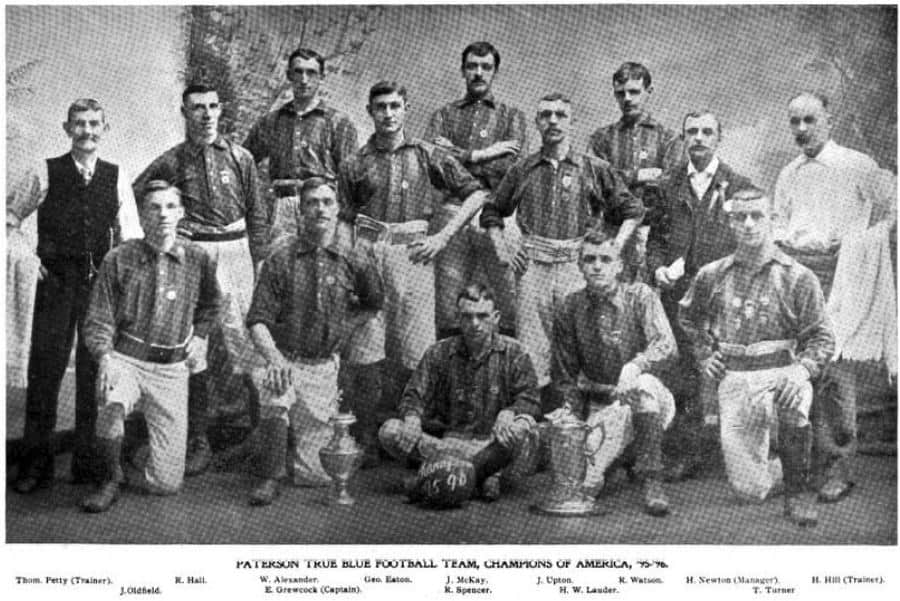
As interest in soccer grew, so did the need for structure and organization. The late 19th century saw the formation of numerous soccer clubs across the country. These clubs were often associated with specific ethnic groups or industrial workplaces, reflecting the demographics of the communities where soccer was most popular.
In 1884, a significant step forward was taken with the establishment of the American Football Association (AFA). This organization, based in Newark, New Jersey, became the first attempt at creating a national governing body for soccer in the United States. The AFA organized competitions and worked to standardize rules, laying the groundwork for the sport’s future growth.
Soccer in American Universities
While professional and amateur clubs were forming in cities, soccer was also finding a home on college campuses. Ivy League schools, in particular, embraced the sport early on. The first intercollegiate soccer match in the United States was played between Princeton and Rutgers in 1869, although this game more closely resembled a hybrid of soccer and rugby.
By the turn of the 20th century, soccer had become a regular fixture in many college athletic programs. The Intercollegiate Association Football League, formed in 1905, included teams from Harvard, Columbia, Cornell, Haverford, and Penn, further legitimizing soccer as a collegiate sport.
Challenges and Competition
Despite its growing popularity in certain circles, soccer faced significant challenges in gaining widespread acceptance in American culture. The sport had to compete with more established American pastimes like baseball and the emerging game of American football. Additionally, the lack of a unified national league and the sport’s association with immigrant communities sometimes hindered its broader appeal.
Nevertheless, the foundations laid during this early period were crucial. The passion of immigrant communities, the formation of local clubs, and the adoption of soccer by educational institutions created a solid base from which the sport would continue to grow and evolve in the coming decades.
The Rise of Professional Soccer: Early Leagues and Competitions
As the 20th century dawned, soccer in the United States began to transition from a primarily amateur pursuit to a more organized and professional endeavor. This period saw the emergence of the first professional leagues and national competitions, setting the stage for soccer’s growth as a spectator sport.
The American Cup: America’s First Soccer Tournament
In 1885, the American Football Association (AFA) established the American Cup, the first significant soccer competition in the United States. This tournament, which ran until 1924, brought together teams from various regions and helped to promote a more standardized version of the game across the country.
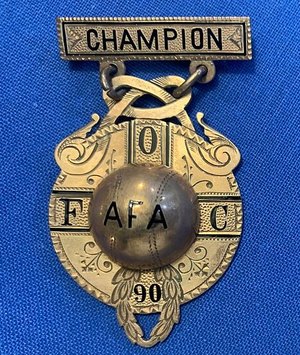
The American Cup played a crucial role in raising the profile of soccer and providing a platform for the best teams and players to showcase their skills on a national stage.
The National Association Football League (NAFBL)
The National Association Football League (NAFBL), founded in 1895, represented one of the first attempts to create a sustainable professional soccer league in America. Based primarily in the Northeast, the NAFBL featured teams from New York, New Jersey, and Pennsylvania. While not a fully professional league by modern standards, it did offer players modest compensation and attracted some of the best soccer talent in the country at the time.
The NAFBL faced numerous challenges, including financial instability and competition from other sports. However, it managed to operate for over two decades, providing a crucial stepping stone in the development of professional soccer in the United States.
The American Soccer League (ASL)
The most significant development in early American professional soccer came with the formation of the American Soccer League (ASL) in 1921. The ASL emerged as the country’s first fully professional soccer league and quickly established itself as one of the premier soccer competitions in the world during the 1920s.

The ASL attracted top talent from both the United States and abroad, particularly from Scotland and England. Teams like Bethlehem Steel, Fall River Marksmen, and New York Giants became powerhouses, drawing large crowds and media attention. The league’s success during this period, often referred to as the “Golden Age” of American soccer, demonstrated the potential for professional soccer to thrive in the United States.
The “Soccer War” and Its Aftermath
The ASL’s rapid rise, however, led to conflicts with the established soccer authorities. A dispute known as the “Soccer War” erupted between the ASL and the United States Football Association (USFA) over issues of control and scheduling. This conflict, which lasted from 1928 to 1929, severely damaged the professional game in America.
The Great Depression further compounded the problems facing professional soccer. Many teams folded due to financial difficulties, and the original ASL ceased operations in 1933. While a new version of the ASL was formed shortly after, it never achieved the same level of success or quality as its predecessor.
Regional Leagues and the Semi-Pro Era
In the wake of the ASL’s decline, soccer in the United States entered a period characterized by regional leagues and semi-professional play. Leagues like the German-American Soccer League in New York and the St. Louis Soccer League gained prominence, keeping the sport alive at a competitive level.
This era also saw the rise of ethnically-based clubs, particularly in urban areas with large immigrant populations. These teams, often representing specific nationalities or cultural groups, played a crucial role in maintaining interest in soccer and developing talent during a challenging period for the professional game.
The U.S. Open Cup
Throughout these ups and downs, one competition remained a constant in American soccer: the U.S. Open Cup. Established in 1914 and originally known as the National Challenge Cup, this tournament brought together teams from various leagues and levels of play. The U.S. Open Cup became an important unifying force in American soccer, providing a national stage for teams to compete and helping to maintain a sense of continuity in the sport’s development.
As the United States moved towards the mid-20th century, soccer had established itself as a part of the American sporting landscape, albeit one that still struggled for mainstream acceptance. The foundations laid during this early professional era, however, would prove crucial for the sport’s future growth and development in the country.
Post-War Revival and International Emergence
The period following World War II marked a significant turning point for soccer in the United States. As the country entered a new era of prosperity and global influence, soccer began to find new footing and gradually increase its presence on both the domestic and international stages.
Post-War Immigration and Cultural Influence
The influx of immigrants from soccer-loving countries in the years following World War II played a crucial role in reinvigorating the sport in America. New waves of immigrants from Europe and Latin America brought with them a passion for soccer, establishing clubs and leagues in their communities. This grassroots growth helped to maintain and expand soccer’s presence across the country.
The 1950 World Cup Miracle: USA vs England
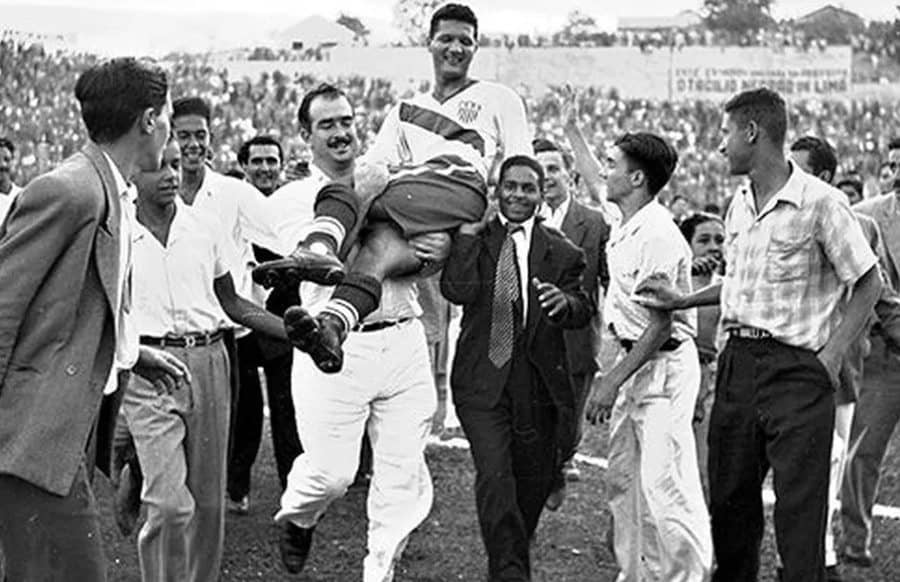
One of the most significant moments in U.S. soccer history occurred during the 1950 FIFA World Cup in Brazil. The United States national team, comprised largely of semi-professional players, shocked the soccer world by defeating England 1-0 in a group stage match. This victory, often referred to as the “Miracle on Grass,” remains one of the greatest upsets in World Cup history and helped to raise the profile of American soccer on the international stage.
Despite this momentous win, the U.S. team was eliminated in the group stage, and the impact on domestic soccer was limited. However, the victory served as a source of pride and inspiration for American soccer enthusiasts and would be remembered as a pivotal moment in the sport’s history in the country.
The Challenge of Competing Sports
During the 1950s and 1960s, soccer faced stiff competition from other sports that were growing rapidly in popularity. American football, basketball, and baseball dominated the sports landscape, attracting the majority of media attention, sponsorship dollars, and young athletes. Soccer struggled to carve out a niche in this competitive environment, often relegated to a niche sport with a dedicated but limited following.
The Birth of the North American Soccer League (NASL)
The late 1960s saw a renewed attempt to establish a viable professional soccer league in the United States. In 1968, the North American Soccer League (NASL) was formed, marking the beginning of a new era in American soccer. The NASL aimed to capitalize on the growing interest in international soccer and create a sustainable professional league that could compete with other major sports in the country.
Initially, the NASL struggled to gain traction, with low attendance and financial difficulties plaguing many teams. However, the league persevered, gradually building a fan base and attracting better talent from both domestic and international sources.
The Pelé Effect and the NASL Boom
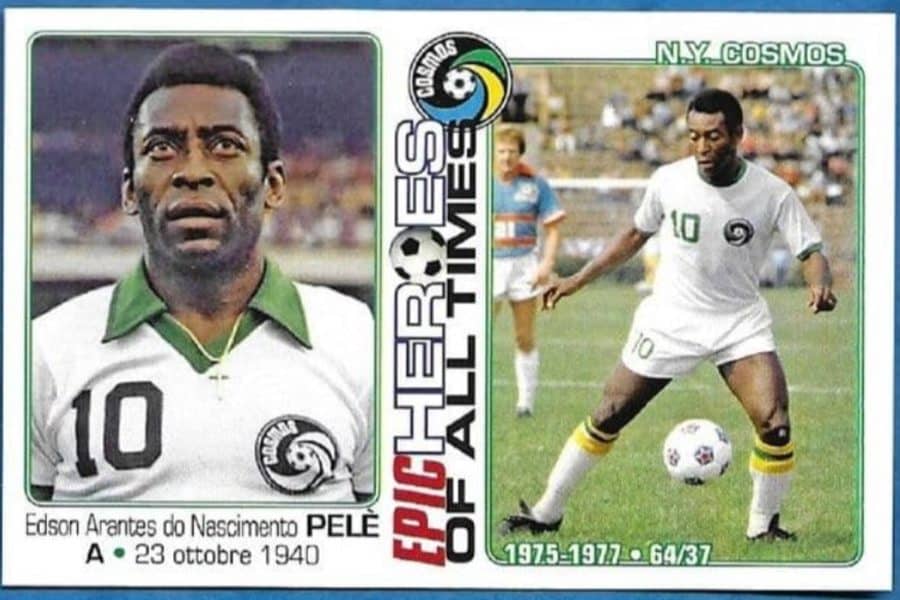
The turning point for the NASL came in 1975 with the signing of Brazilian soccer legend Pelé by the New York Cosmos. Pelé’s arrival in America created a media frenzy and brought unprecedented attention to the league. Suddenly, soccer was front-page news, and NASL games were attracting large crowds and television coverage.
Following Pelé’s lead, other international stars like Franz Beckenbauer, Johan Cruyff, and George Best joined NASL teams, further raising the league’s profile and the quality of play. The late 1970s saw a boom in the NASL’s popularity, with expansion teams joining the league and attendance figures reaching new heights.
Youth Soccer Movement
Parallel to the growth of professional soccer, a significant youth soccer movement began to take shape in the United States during this period. Parents, attracted by soccer’s inclusive nature and relatively low cost, began enrolling their children in increasing numbers. Youth leagues and tournaments proliferated across the country, laying the groundwork for a new generation of American soccer players and fans.
The NASL’s Decline and Legacy
Despite its initial success, the NASL faced mounting challenges in the early 1980s. Overexpansion, financial mismanagement, and a lack of television revenue led to the league’s eventual collapse in 1984. However, the NASL’s impact on American soccer was significant and lasting. It had introduced millions of Americans to professional soccer, inspired a generation of young players, and demonstrated that there was a market for the sport in the United States.
The post-war period, culminating in the NASL era, represented a crucial phase in the development of soccer in America. While the sport still faced challenges in achieving mainstream acceptance, the foundations laid during this time would prove essential for its future growth and the eventual establishment of Major League Soccer in the 1990s.
The 1994 World Cup and the Birth of Major League Soccer
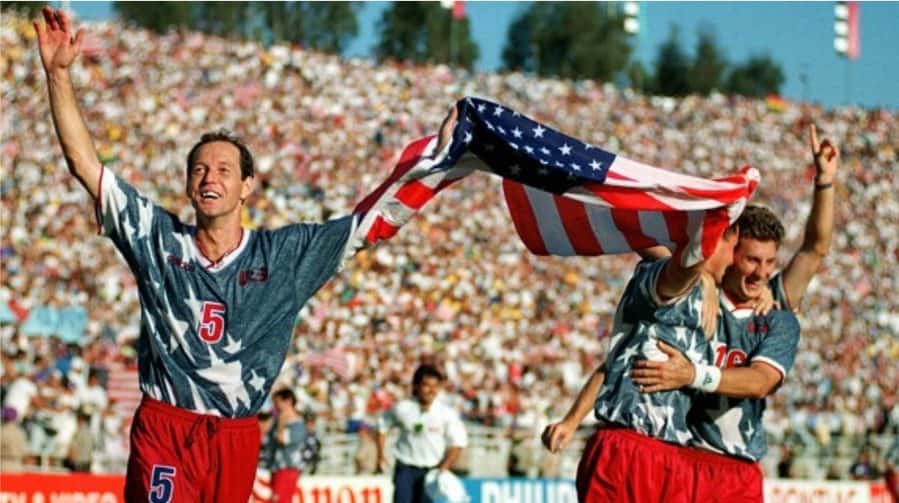
The 1990s marked a transformative decade for soccer in the United States, highlighted by the country’s hosting of the 1994 FIFA World Cup and the subsequent launch of Major League Soccer (MLS). These events would prove to be watershed moments, propelling soccer to new heights of popularity and establishing a sustainable professional league that continues to thrive today.
Winning the World Cup Bid
In 1988, FIFA made the surprising decision to award the 1994 World Cup to the United States. This choice was met with skepticism by some in the international soccer community, given America’s lack of a top-tier professional league and the sport’s relatively low profile in the country. However, FIFA saw the potential for growth in the large American market and viewed the tournament as an opportunity to expand soccer’s global reach.
Preparations and Expectations
The years leading up to the 1994 World Cup saw intense preparations across the United States. New stadiums were built or renovated, and a massive promotional campaign was launched to generate interest in the tournament. The U.S. Soccer Federation worked tirelessly to ensure that the event would be a success, both logistically and in terms of public engagement.
There were concerns about whether Americans would embrace the World Cup, given the country’s historical preference for other sports. However, these doubts were quickly dispelled as the tournament approached and excitement began to build.
The 1994 World Cup
The 1994 FIFA World Cup exceeded all expectations, becoming the most financially successful and well-attended World Cup in history at that time. The tournament drew massive crowds, with an average attendance of nearly 69,000 spectators per match, a record that still stands today. The American public embraced the event with enthusiasm, creating a festive atmosphere in host cities across the country.
On the field, the U.S. national team performed admirably, advancing to the Round of 16 before narrowly losing to eventual champions Brazil. The team’s performance, particularly a dramatic victory over Colombia in the group stage, helped to capture the imagination of the American public and generate newfound respect for U.S. soccer on the international stage.
Legacy and Impact
The success of the 1994 World Cup had a profound and lasting impact on soccer in the United States. It demonstrated that there was a significant market for high-level soccer in the country and left a legacy of improved infrastructure and increased interest in the sport. Perhaps most importantly, it set the stage for the creation of a new professional league, as FIFA had made the establishment of such a league a condition of awarding the World Cup to the United States.
The Formation of Major League Soccer (MLS)
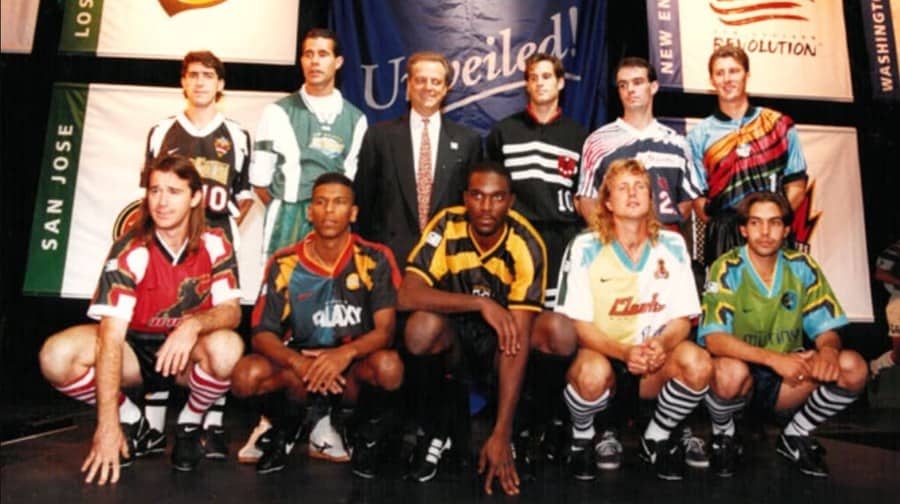
In the aftermath of the World Cup, plans were set in motion to fulfill the promise of creating a new top-tier professional soccer league. Major League Soccer (MLS) was officially formed in 1993, with the inaugural season kicking off in 1996. The league began with ten teams, a mix of new franchises and clubs with roots in previous American soccer leagues.
MLS faced numerous challenges in its early years, including financial struggles, low attendance in some markets, and skepticism from both soccer purists and mainstream sports fans. However, the league persevered, gradually building a solid foundation and expanding its reach.
Early MLS Years: Challenges and Growth
The first decade of MLS was marked by both struggles and signs of progress. The league adopted a unique single-entity structure, where all teams were owned by the league itself, to ensure financial stability. This model, while controversial, helped MLS weather early financial storms and allowed for controlled growth.
Key milestones in the early years of MLS included:
- The introduction of soccer-specific stadiums, beginning with Columbus Crew Stadium in 1999
- The signing of high-profile American players like Landon Donovan and DaMarcus Beasley
- Expansion into new markets, including Chicago, Miami, and Los Angeles
Despite these positive developments, MLS still faced challenges in attracting top international talent and achieving profitability. The league underwent a period of contraction in 2002, reducing from 12 teams to 10, but this proved to be a temporary setback in its long-term growth trajectory.
Building a Sustainable Model
As MLS moved into its second decade, the league began to find its footing and develop a sustainable model for growth. Key factors in this evolution included:
- The introduction of the Designated Player Rule in 2007, allowing teams to sign high-profile players outside of the salary cap
- Continued expansion into new markets, with a focus on cities with strong soccer cultures
- Improved television deals and increased media coverage
- Growing attendance figures and fan engagement, particularly in markets with strong supporter cultures
These developments helped MLS to steadily increase its profile and financial stability, setting the stage for more rapid growth in the following years.
The 1994 World Cup and the subsequent launch of MLS represented a pivotal moment in the history of soccer in the United States. While challenges remained, these events laid the groundwork for the sport’s continued growth and increasing prominence in the American sports landscape. The success of the World Cup and the perseverance of MLS in its early years demonstrated that soccer had finally found a permanent home in the United States, with a bright future ahead.
The Modern Era of MLS
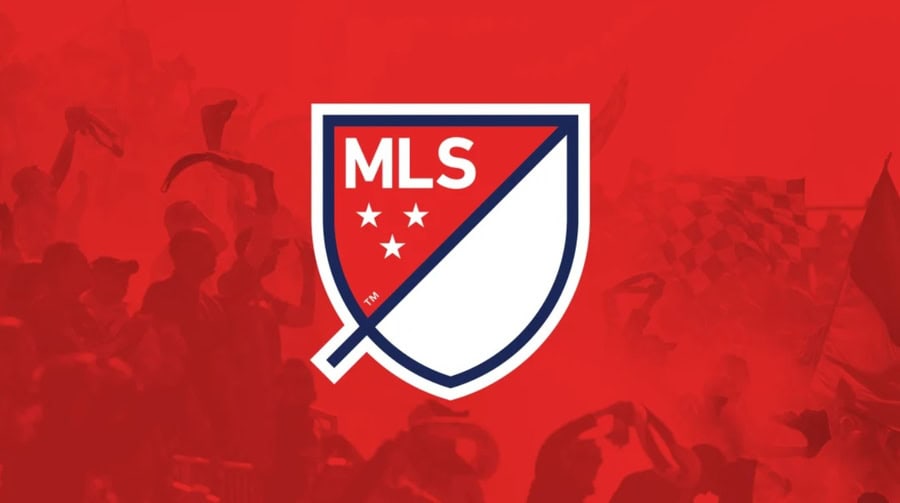
As Major League Soccer entered its third decade, the league experienced a period of unprecedented growth and increasing popularity. This era has been characterized by rapid expansion, improved quality of play, and a growing presence in the American sports landscape.
Expansion and New Markets
One of the most notable aspects of MLS’s growth in recent years has been its aggressive expansion strategy. The league has more than doubled in size since 2005, growing from 12 teams to 29 teams as of the 2023 season. This expansion has brought professional soccer to new markets across the United States and Canada, tapping into existing soccer fan bases and creating new ones.
Key expansion milestones include:
- The addition of Toronto FC in 2007, marking MLS’s entry into the Canadian market
- The successful launch of Seattle Sounders FC in 2009, which set new attendance records and became a model for future expansion teams
- The introduction of teams in major markets like New York City (NYCFC) and Los Angeles (LAFC), as well as smaller but soccer-passionate cities like Portland and Atlanta
- San Diego FC joining the league for the 2025 season, making it the 30th MLS franchise.
This expansion has not only increased the league’s geographic footprint but has also brought in new ownership groups, often with deep pockets and ambitious plans for their clubs.
Improved Infrastructure and Facilities
Alongside expansion, MLS has seen significant improvements in its infrastructure, particularly in the realm of soccer-specific stadiums. The trend towards purpose-built venues, which began with Columbus Crew Stadium in 1999, has accelerated in recent years. As of 2023, the majority of MLS teams play in soccer-specific stadiums, providing better atmospheres for fans and more appropriate venues for the sport.
Notable new stadiums include:
- Allianz Field (Minnesota United FC)
- Mercedes-Benz Stadium (Atlanta United FC)
- Banc of California Stadium (Los Angeles FC)
- Q2 Stadium (Austin FC)
These modern facilities have not only improved the match-day experience for fans but have also provided teams with new revenue streams and increased their ability to attract top talent.
Rising Quality of Play
The quality of play in MLS has steadily improved over the years, thanks to a combination of factors:
- Designated Player Rule: Introduced in 2007, this rule has allowed teams to sign high-profile players outside of the salary cap. It has brought stars like David Beckham, Thierry Henry, and Zlatan Ibrahimović to the league, raising its profile and quality.
- Improved Youth Development: MLS teams have invested heavily in their academy systems, producing a new generation of homegrown talent. Players like Tyler Adams, Alphonso Davies, and Brenden Aaronson have emerged from MLS academies to become international stars.
- Targeted Allocation Money (TAM): This mechanism, introduced in 2015, has allowed teams to invest in a higher caliber of player, improving the overall depth and quality of rosters across the league.
- International Recruitment: MLS has become an increasingly attractive destination for players from South America, Europe, and Africa, bringing a diverse range of talents and styles to the league.
Growing Fan Culture and Attendance

One of the most visible signs of MLS’s growth has been the development of vibrant fan cultures across the league. Supporter groups, inspired by international soccer traditions but with distinctly American flavors, have become integral to the MLS experience. Teams like Seattle Sounders, Portland Timbers, and Atlanta United have set new standards for fan engagement and atmosphere in American sports.
Attendance figures have reflected this growing enthusiasm:
- Atlanta United set a new MLS attendance record in 2019, averaging over 52,000 fans per game
- Several teams consistently sell out their stadiums, with strong season ticket bases
- The league’s overall average attendance has grown significantly, competing with and sometimes surpassing established leagues like the NBA and NHL
Media Coverage and Digital Presence
MLS has also made significant strides in its media presence and digital engagement:
- Improved television deals with major networks like ESPN, Fox, and Univision have increased the league’s visibility
- The launch of MLS Season Pass on Apple TV in 2023 marked a groundbreaking streaming deal, making all MLS matches available globally on a single platform
- Social media engagement has grown rapidly, with MLS teams and players building strong followings and connecting directly with fans
Challenges and Future Outlook
Despite its growth, MLS still faces challenges as it seeks to establish itself among the world’s top soccer leagues:
- Competition from European leagues for viewership and talent
- The need to continue improving the quality of play while maintaining financial stability
- Balancing expansion with the development of existing markets
However, the overall trajectory of MLS in the modern era has been one of growth and increasing relevance. As the league continues to evolve, it is poised to play an increasingly important role in both the American sports landscape and the global soccer ecosystem.
The modern era of MLS has been characterized by rapid expansion, improved quality, and growing cultural relevance. While challenges remain, the league’s trajectory suggests a bright future for professional soccer in the United States.